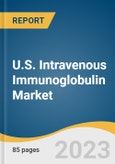The unmet need is high in patients, which provides immense growth opportunities for players. For instance, the treatment cost for IVIG is high, making it hard for patients to afford it without insurance or Medicare coverage. Thus, the entry of novel low-cost IVIG treatment can lead to a paradigm shift. Moreover, as per the National Institutes of Health, in 2020, over 500,000 cases of PIDD went undiagnosed, which demonstrates the high unmet need for pharmaceuticals; if diagnosed, Immunoglobulin (Ig) replacement therapy is the standard treatment for PIDD.
Regulatory and reimbursement support is acting as key drivers. For instance, as per 2021 Medicare updates, Medicare B will cover Hizentra therapy for CIDP patients as maintenance therapy. This is expected to improve access to the treatment in insured patients, as the treatment is expensive. Furthermore, in February 2021, Panzyga by Pfizer received approval for supplemental BLA. The entry of new products into the market is anticipated to act as a crucial driver in the coming years.
Leading participants in the U.S. IVIG market are developing a variety of projects and biological products based on their patented technology. In July 2021, Octagam 10% was approved by the FDA for the treatment of dermatomyositis in adults. The launch of Octagam 10% is anticipated to have a significant impact on patients with dermatomyositis, improving the armamentarium of available treatments. Moreover, in November 2022, Biotest AG received FDA approval for Yimmugo, a next-generation IVIG.
The U.S. IVIG market is oligopolistic in nature with companies such as Grifols, S.A.; CSL Behring; and Octapharma AG, holding a major share. Other small-scale players are investing in clinical trials and R&D for the production of novel IVIG products in an attempt to gain market share. Moreover, increasing attempts by major players to expand their presence with approvals for new indications for existing products is further expected to increase competitive rivalry in the market.
U.S. Intravenous Immunoglobulin Market Report Highlights
- In 2022, primary immunodeficiency diseases held the largest share of the U.S. IVIG market attributable to long-term therapy requirements and expensive treatments
- Chronic Inflammatory Demyelinating Polyneuropathy (CIDP) is projected to grow at the fastest rate attributable to the increasing prevalence of the condition and coverage of drugs under medicare
- Hospital pharmacy held the largest share of the U.S. IVIG market in 2022 owing to a large number of hospital pharmacies and easy availability of products in the hospitals
- Key players in the U.S. IVIG market include companies such as Octapharma AG; LFB Biotechnologies; Grifols, S.A.; and CSL Behring
Table of Contents
Companies Mentioned
- Biotest AG
- Octapharma AG
- LFB Biotechnologies S.A.S
- China Biologics Products Holdings, Inc.
- Grifols, S.A.
- Kedrion S.p.A
- CSL
- Takeda Pharmaceutical Company Limited
- Bio Products Laboratory Ltd.
- Pfizer, Inc.
- ADMA Biologics, Inc.
Methodology

LOADING...
Table Information
| Report Attribute | Details |
|---|---|
| No. of Pages | 85 |
| Published | May 2023 |
| Forecast Period | 2022 - 2030 |
| Estimated Market Value ( USD | $ 5.74 Billion |
| Forecasted Market Value ( USD | $ 10.42 Billion |
| Compound Annual Growth Rate | 7.7% |
| Regions Covered | United States |
| No. of Companies Mentioned | 11 |









